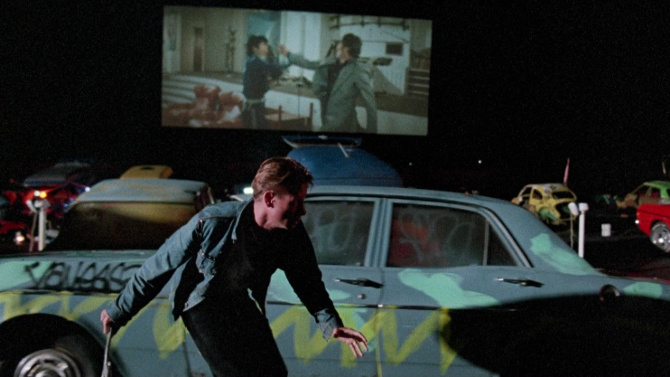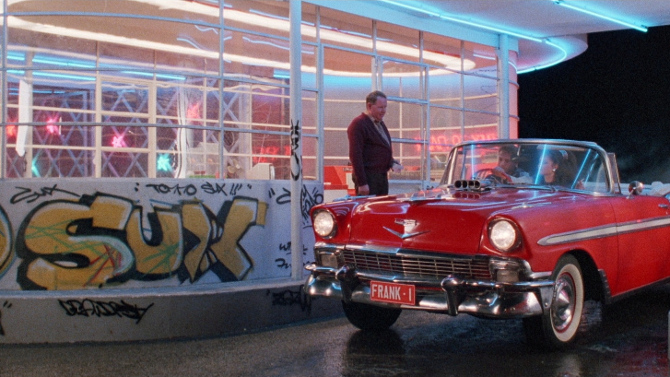Come with me, and you’ll be, in a world of pure Ozploitation. Had you going there, didn’t I?. . . you thought I was going full Willy Wonka, but rather, I am transporting you to a very different landscape, that of the Australian exploitation film.
Growing out of the R rating after it was instituted (as well as helped by new tax cuts), this Australian New Wave rose out of the 1970s and 80s (a little later than its American counterpart), and is a broad term that refers to no specific genre, encompassing horror, comedy, sexploitation, post-apocalyptic, dystopic and so much more – though it does slant the traditional norms of culture at the time. It is hard to argue that the Mad Max franchise, directed by George Miller, would not be the best known example of this type of movie.
A film that feeds off of the Mad Max frenzy, fusing it with concepts found in other movies like Luis Buñuel’s 1962 drama The Exterminating Angel (it may also remind you of the 2000 Japanese feature Battle Royale), is 1986’s Dead End Drive-In, directed by Brian Trenchard-Smith (one of Quentin Tarantino’s favourite directors – and his top pick from the filmmaker), a horrific dystopic vision of the future.
Set in an alternate 1995, it is a world that has been hit hard. Terrorist attacks, riots, a major financial crisis and many other events have crippled things, and while the rich cloister themselves away behind their walled neighbourhoods, city streets are basically a war zone. Vehicles, due to the lack of production, have become a hot commodity, and it does not take long for looters to quickly disassemble cars for needed parts. Carboys – the name for roving gangs of youthful hoodlums who hang out in cars, patrol the streets, terrorizing anyone that looks to have something they want. Tow-truck drivers grapple desperately for jobs to recover even the junkiest of vehicles, as they are worth so very much. Also important to note, cops are corrupt and most of the population is unemployed.
It is within this scenario that Crabs (Ned Manning), our protagonist, tries to live his life. With a relatively safe job and loving mother and brother, he is a rare example of a clean living good guy – exercise is his drug of choice. Despite weird rumours swirling around a chain of drive-in movie theatres that have cropped up, Crabs borrows his brother’s 1956 Chevrolet and takes his girlfriend Carmen (Natalie McCurry) to the nearest one. Having two rates (one for adults, the other for the unemployed), Crabs lies to pay the lesser fee. Whilst making love in the back of the car (no one has ever done that at a drive-in!), someone nabs two of the tires, stranding them at the locale. They try to report the incident to the manager, Thompson (Peter Whitford), who tells them to spend the night and return in the morning. It does not take long for them to realize that they are trapped inside, a situation that does not seem to bother Carmen too much, but very much worries Crabs. Will the budding couple be able to escape their unusual predicament?
Mashing together a punk aesthetic with stunning neon and graffiti culture, it is a vivid world with an impressive depth. Keen observers will see the strange beauty of fires burning in the background or the actions on the drive-in screen matching those happening in the forefront (two of those movies, 1975’s The Man from Hong Kong and 1982’s Turkey Shoot are also directed by Trenchard-Smith). You will also catch sly little inside jokes. . . I use the word sly as one of said jokes is a poster for an upcoming movie, Rambo 8: Rambo Takes Russia, starring, you guessed it, Sylvester Stallone. Once again, it is an example of a filmmaker and his team doing an impressive amount with a very small budget – eye candy in every shot.
Weaving a fascinating topic that elevates above the typical exploitation picture, there is a disconnect between the youth of this society and the adults (especially the rich and powerful). Drawing on a teens love of the drive-in, the government has made sure that anyone who purchases an ‘unemployed’ ticket has their car secretly dismantled by the cops, so that they can never leave. Like some sort of bizarre prison or concentration camp, the horrific life outside the walls mixed with apathy find those trapped inside lacking interest in escaping. Exploiting them by giving them what they want: darkly lit rooms, junk food, drugs, new wave music and alcohol are provided – so is birth control, after all, who wants the dregs of society procreating. All of this feeds into their ennui. Many live like vampires, sleeping in their trunks or covered cars during the day, only to rise for the violent evening films. The masses inside care not for freedom, Crabs (who wholly rejects the languor of this society) finds himself struggling to find any allies, including his rather indifferent girlfriend.
Also, there is something gripping about a drive-in. Perhaps it is the nostalgia of it, or simply the difference compared to watching a flick in a dark theatre rather than outside under the stars, but the disappearance of this form of movie-watching feeds into this film’s intrigue. It is a shame that most people under the age of thirty will likely never experience it. A final note on the subject, Trenchard-Smith actually saw Sam Peckinpah’s Major Dundee at the drive-in where this was filmed, likely providing some inspiration for this feature.
A unique motion picture to be sure, Dead End Drive-In is a fun time. Though it does lag at times in the middle, its mix of dystopia, action, drama, horror, and social commentary makes for an entertainingly alarming vision of the future. With some amazing stunts, perhaps the penultimate one is where a car makes a one hundred and sixty three foot jump (a world record at the time) through a giant sign – an example of the thrills found in the low budget, B movie flick. A costly venture – $75,000 was a fair amount of their budget (in the end, more than the film would earn in its native land), yet it was well worth it. So, escape the conventions of today for this film of yesteryear, it will ramp you up.



